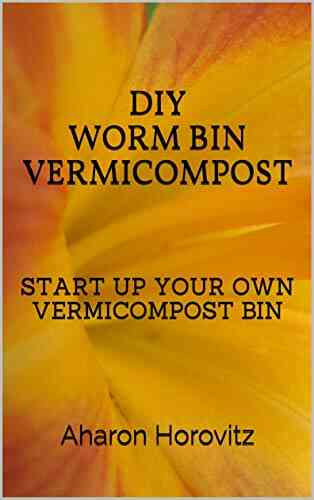The Ultimate Guide to Diy Worm Bin Vermicompost: Create Your Own Eco-Friendly Fertilizer

Do you want to reduce waste, save money, and create nutrient-rich soil for your beloved plants? Look no further! In this comprehensive guide, we will explore the exciting world of worm bin vermicompost. Get ready to turn your kitchen scraps into black gold!
What is Vermicomposting?
Vermicomposting is the process of using worms to break down organic matter, such as fruit and vegetable scraps, coffee grounds, and shredded paper, into nutrient-rich compost. It is an efficient and environmentally friendly way to recycle kitchen waste and create an incredible soil amendment for your garden.
One of the most popular DIY vermicomposting methods is setting up a worm bin at home. Let's dive into the step-by-step process of creating your very own worm bin and reaping the benefits of this sustainable practice!
5 out of 5
| Language | : | English |
| File size | : | 2283 KB |
| Text-to-Speech | : | Enabled |
| Enhanced typesetting | : | Enabled |
| Print length | : | 21 pages |
| Lending | : | Enabled |
| Screen Reader | : | Supported |
Step 1: Choosing the Right Worms
The key to successful vermicomposting lies in selecting the right type of worms. The two most commonly used worms for vermicomposting are:
- Red Wigglers (Eisenia fetida): These worms are small, robust, and highly efficient at breaking down organic matter.
- European Nightcrawlers (Eisenia hortensis): These larger worms are suitable for those who generate more waste or have a larger worm bin.
When buying worms, ensure that they are healthy and active. Store them in a cool, dark place until ready for use.
Step 2: Setting Up the Worm Bin
Now that you have your worms, it's time to create their new home.
Materials needed:
- A plastic or wooden bin with a lid
- Drill or hammer and nails
- Bedding materials (shredded newspaper, cardboard, coconut coir)
- Water
Instructions:
- Drill or poke holes in the bin's lid and sides to ensure proper airflow.
- Add a layer of bedding material to the bin, moistening it with water until it resembles a damp sponge.
- Gently introduce the worms to their new bedding and avoid direct sunlight on the bin.
- Cover the bin with a lid to create a dark and moist environment for the worms to thrive.
Step 3: Feeding Your Worms
Worms can devour up to their own weight in organic matter every day, so it's essential to feed them a balanced diet.
Good food options for worms:
- Fruit and vegetable scraps
- Coffee grounds and tea bags
- Eggshells and crushed oyster shells for grit
- Shredded newspaper and cardboard
Foods to avoid:
- Meat
- Dairy products
- Fatty foods
- Spicy or seasoned foods
- Citrus fruit
Remember to bury the food scraps under the bedding to avoid attracting pests and unpleasant odors.
Step 4: Maintenance and Harvesting
Regular maintenance is vital for a healthy worm bin.
Monitoring:
- Check the moisture level regularly. The bedding should feel moist, but not sodden.
- Monitor the temperature, aiming for a range of 55°F to 77°F (13°C to 25°C) for optimal worm activity.
Harvesting the compost:
In approximately three to six months, your worm bin will be brimming with nutrient-rich worm castings and compost. Here's how to harvest it:
- Push all the contents of the bin to one side and add fresh bedding material to the empty side. This will attract the worms to the new area.
- Over the next few weeks, the worms will move to the new bedding. Once most of the worms have migrated, you can harvest the black gold from the other side.
- Sift the compost to separate the worms from the finished vermicompost.
- Return the worms to the bin and repeat the process.
The Benefits of Diy Worm Bin Vermicompost
Creating your own worm bin vermicompost has numerous advantages:
- Environmentally friendly: Vermicomposting helps divert organic waste from landfills, reducing methane emissions and environmental pollution.
- Rich soil amendment: Worm castings are packed with essential nutrients and beneficial microorganisms that promote healthy plant growth.
- Cost-effective: Producing your own fertilizer saves money on commercial products.
- Reduces waste: Vermicomposting provides a sustainable solution for kitchen scraps, coffee grounds, and yard waste.
- Creates sustainable habits: Engaging in vermicomposting encourages a greener lifestyle and teaches ecological responsibility to future generations.
Starting your own worm bin vermicompost is a rewarding and educational journey. From choosing the right worms to maintaining and harvesting black gold, each step contributes to a more sustainable and eco-friendly world. By utilizing kitchen scraps and organic waste, you can create nutrient-rich compost that will nourish your plants and reduce your environmental impact. So, roll up your sleeves, get your hands dirty, and join the growing community of worm bin vermicompost enthusiasts!
5 out of 5
| Language | : | English |
| File size | : | 2283 KB |
| Text-to-Speech | : | Enabled |
| Enhanced typesetting | : | Enabled |
| Print length | : | 21 pages |
| Lending | : | Enabled |
| Screen Reader | : | Supported |
For 17 years I lived in a village in Israel. When I first reached the village, I did not even have a basic knowledge of growing plants.
Before that, I lived in the city and the few attempts I made to grow potted plants failed. But as soon as we moved to the village, I suddenly owned a 500-square-meters plot of land, which I considered a huge area.
The ground was naked with no growth except weeds. At this point, I began my journey of getting to know the land and everything above and below it, a difficult process of trial and error, where my primary teacher was the Internet and the errors that I made, and I made quiet a few.
Over time, I began to acquire knowledge, and I built my first compost container, which, in time, was followed by a vermicompost container. It was a unique experience for me, because until this point in my life, worms seemed to have a very negative connotation. Suddenly, I discovered this fantastic form of life, and was surprised by the change in my way of thinking about these little creatures.
I wrote this book because I know that the knowledge I have acquired could be useful for others. It is true that no teacher is better than the experience itself, but the experience of others can significantly speed up the learning process and give a serious incentive to start the process.
I hope that you will find the answers to the questions that concern you, about starting the process of owning a vermicompost worm bin and that it will guide you through the more advanced stages of the process.
Vermicompost is full of microorganism, fungi and bacteria that beneficial the soil. Microbial activity in worm castings is much higher than in the soil and organic matter that the worm eats.
Worm compost improves soil structure, texture, and aeration, as well as increasing its water-holding capacity. Your plants will grow stronger and have deeper root systems and disease resistance.
Vermicompost keeps pathogens from becoming virulent and attacking your plants.
In addition, fertilizers that contain certain chemicals can cause severe damage to humans' organs, or the nervous system. By using vermicompost, you don't have to be concerned about any risks associated with such chemicals, because it is all-natural.
Fruits and vegetables that grow with vermicomposting will grow larger and in some cases even taste better. Fruits and vegetables that grow in this manner cost more in the markets due to their better quality. You can efficiently produce the same high level of results in your home or garden using vermicomposting to fertilize your plants naturally.
Do you want to contribute by writing guest posts on this blog?
Please contact us and send us a resume of previous articles that you have written.




















Light bulbAdvertise smarter! Our strategic ad space ensures maximum exposure. Reserve your spot today!

 Jeremy MitchellThe Epic Adventures Continue: Cast In Flight - The Chronicles of Elantra 12
Jeremy MitchellThe Epic Adventures Continue: Cast In Flight - The Chronicles of Elantra 12 Stan WardFollow ·4.5k
Stan WardFollow ·4.5k Rob FosterFollow ·16k
Rob FosterFollow ·16k Adrian WardFollow ·7.2k
Adrian WardFollow ·7.2k Benjamin StoneFollow ·17.8k
Benjamin StoneFollow ·17.8k Demetrius CarterFollow ·4.2k
Demetrius CarterFollow ·4.2k Chase MorrisFollow ·7.7k
Chase MorrisFollow ·7.7k Gus HayesFollow ·8.3k
Gus HayesFollow ·8.3k Forrest ReedFollow ·3.2k
Forrest ReedFollow ·3.2k

 Dwayne Mitchell
Dwayne MitchellSaving The Maldives: The Floating Island
The Maldives, known for...

 Ethan Mitchell
Ethan MitchellManaging The Production Hour: Mastering Efficiency and...
As businesses strive to meet growing demands...

 Virginia Woolf
Virginia WoolfThe Food Lab: Better Home Cooking Through Science
Have you ever wondered why some...

 Jeff Foster
Jeff FosterThe Darling Songbirds: The Songbirds of Darling Bay
When it comes to enchanting melodies and...

 Eli Blair
Eli BlairDeath And New Life In Pandemic
The COVID-19 pandemic has brought about...

 Dave Simmons
Dave SimmonsThe Unstoppable Nathan Run: A Thrilling Journey Into John...
When it comes to gripping thriller novels,...

 Amir Simmons
Amir SimmonsDistant Horizon Backyard Starship: Exploring the Cosmos...
The mysteries of the universe...

 Simon Mitchell
Simon MitchellUnveiling the Secrets: The DNA of a Disciple - A...
Do you ever wonder what it takes to become a...

 Samuel Taylor Coleridge
Samuel Taylor ColeridgeThe Epic Tale of Snake River Slaughter: Matt Jensen, The...
The Snake River, winding through the...

 Ray Blair
Ray BlairThe Ultimate Covid Alphabet For Teachers: The Key to a...
With the Covid-19 pandemic still ongoing,...

 Gage Hayes
Gage HayesFor The Sake Of Family: Why Prioritizing Our Loved Ones...
Family is the backbone of...
5 out of 5
| Language | : | English |
| File size | : | 2283 KB |
| Text-to-Speech | : | Enabled |
| Enhanced typesetting | : | Enabled |
| Print length | : | 21 pages |
| Lending | : | Enabled |
| Screen Reader | : | Supported |



















